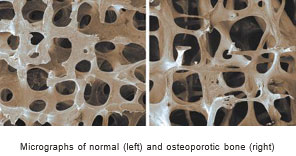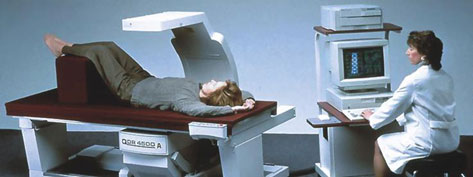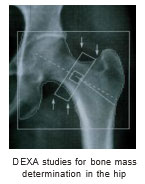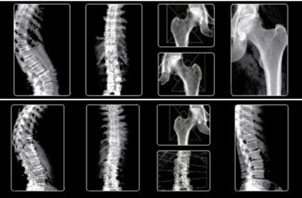Osteoporosis and Bone Densitometry English


What is Osteoporosis?

Osteoporosis is a silent disease in which bones become fragile and more likely to break. If not prevented, or left untreated, osteoporosis can progress painlessly until a bone breaks. These fractures occur typically in the hip, spine and wrist.
Any bone can be affected, but of special concern are fractures of the hip and spine as they almost always require hospitalisation and may cause prolonged or permanent disability or deformity.
Who is at risk?
Osteoporosis affects millions of people all over the world resulting in disabilities that could have been easily prevented. The World Health Organisation estimates that nearly 30% of all postmenopausal women suffer from osteoporosis.
While women are four times more likely than men to develop the disease, men also suffer from osteoporosis. Some of the risk factors are:
- Age. Your bones become less dense and weaker as you age.
- Gender. Women are at greater risk as they have less bone tissue and lose bone more rapidly because of menopausal changes .
- Bone Structure and Body Weight. Small-boned and thin women are at greater risk.
- Lifestyle. Smoking, excessive alcohol, inadequate intake of calcium, and Iittle or no exercise add to the risk.
- Medications and Disease. Certain medicines such as steroids, and diseases like overactive thyroid, rheumatoid arthritis, and prolonged immobilisation increase the risk .
- Family History Susceptibility to fracture may be, in part, hereditary.
Bone mass measurement
Osteoporosis can be prevented and treated, but only if you take the initiative to talk to your doctor about a bone density test - also called bone densitometry. The information from a bone density test enables your doctor to evaluate your bone health and decide on any treatment that may be necessary.
There are several ways to measure bone mass density. NMC Royal Hospital offers the latest state-of-the-art facilities for two of the most accurate and widely accepted means of bone mass measurement.
DEXA Bone Densitometry

Dual Energy X-ray absorptiometry (DEXA) is recognised to be the gold standard for bone mass measurement. It is a fast, convenient and extremely precise method to evaluate bone mass and monitor response to therapy.
It measures bone density in the spine, hip and the forearm - the sites commonly predisposed to fractures.
The procedure causes no pain or discomfort, and its radiation exposure is clinically insignificant. Furthermore, no special preparation is required.

The data from a bone density test is compared against the expected values in someone of your age, sex and size, and also against the estimated peak bone density of a healthy young aduIt of the same sex. This information enables your doctor to determine whether you are at risk for fracture and the best course of action to follow. It also determines your rate of bone loss and/or monitor the effects of treatment if the test is conducted at intervals of a year or more.
Ultrasound Bone Densitometry
Bone mass can also be measured using ultrasonography - the same safe technique that is employed, for example, during pregnancy to manitor foetal development.
In this case, the heel bone provides the ideal site for a precise quantitative assessment of bone health . The test is quick and simple and avoids exposure to ionising radiation.
Preventing Osteoporosis
Building strong bones, especially before the age of 30, can be the best defence against developing osteoporosis later. A comprehensive program that can help prevent osteoporosis includes:
- A balanced diet rich in calcium and vitamin D. Your doctor may recommend a supplement if your diet doesn't contain enough of these nutrients.
- Weight bearing exercises that work against gravity, such as walking or jogging, are useful in building and maintaining strong bones.
- A healthy lifestyle with no smoking and limited alcohol intake.
- Bone density testing and medication when appropriate.

Treating Osteoporosis
Although there is no real total cure for osteoporosis, there are steps you can take to slow its progress, and possibly to increase your bone mineral density with appropriate therapy. Some of the treatment options are listed below. Before commencing any treatment, however, you must consult your doctor to ascertain as to which would be most suitable in your case.
- Calcium - adequate daily calcium and Vitamin D supplements are usually recommended to increase bone density.
- Exercise, while good for osteoporosis, should not put any sudden or excessive strain on your bones. Care should be taken to avoid falls and when Iifting heavy objects.
- Hormone Replacement Therapy ( H RT) Estrogen, a hormone produced by the ovaries, is important for maintaining bone in women. It is often prescribed at naturally occurring or early / surgical menopause.
- Calcitonin has been shown to reduce bone loss and to increase bone density in both men and women suffering from osteoporosis.
- Biphosphonates (alendronate) and Selective Estrogen Receptor Modulators (SERMS) (Raloxifene) are other compounds that inhibit bone loss and risk of fractures.
Several other medications are currently under investigation and offer promising prospects for osteoporosis prevention and treatment in the future.



